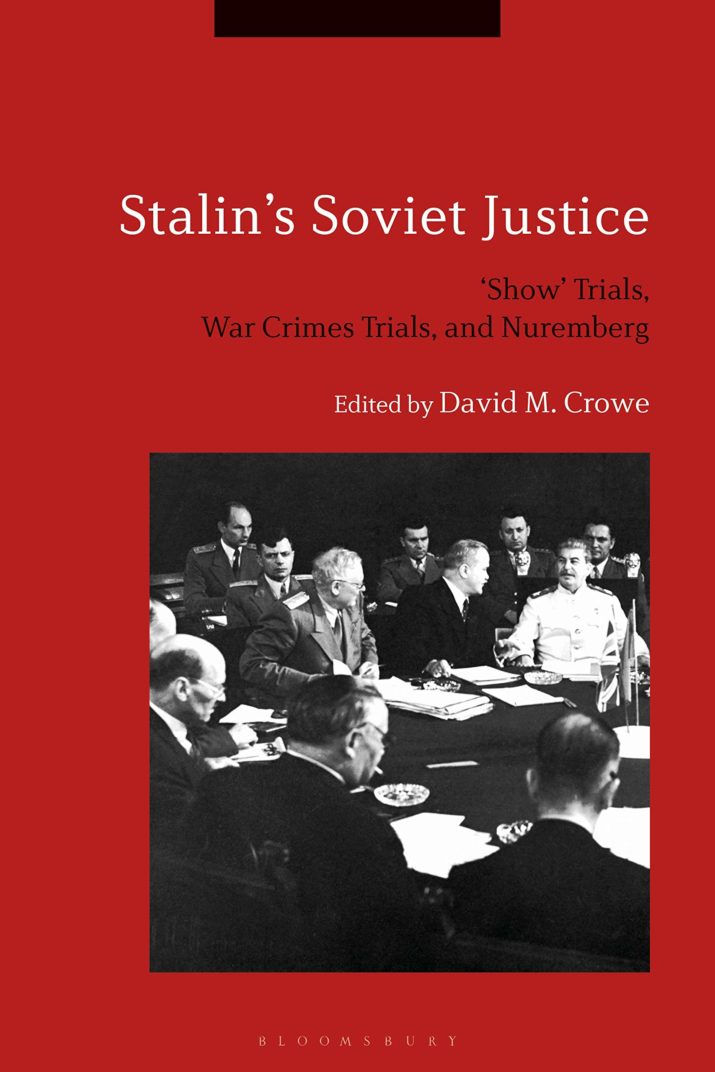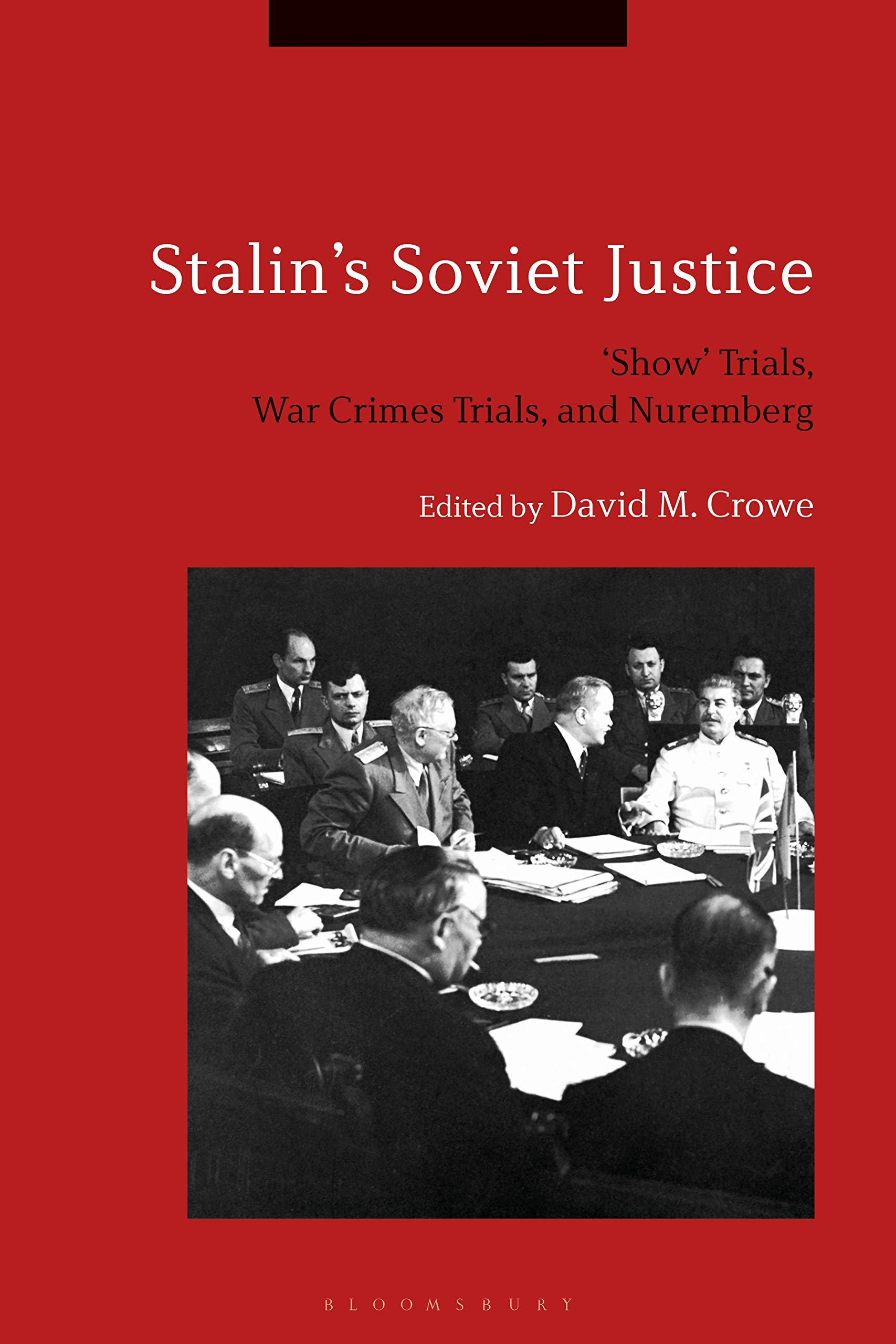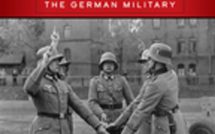
Stalin’s Soviet Justice: “Show” Trials, War Crimes Trials, and Nuremberg, edited by David M. Crowe

Stalin’s Soviet Justice, edited by David M. Crowe, analyzes how the legacy of pre-revolutionary concepts and practices of justice influenced the Soviet legal system. In doing so, it illustrates how far Soviet legal history has advanced since the opening of the Russian archives in the early 1990s. Although the chapters approach the topic through events spanning from the late-nineteenth century “show” trials of Bolsheviks and other agitators to the 1948 Genocide Convention, each contributes to at least one of three overall themes: the development of the Leninist/Stalinist legal system and the domestic prosecution of war crimes, the influence of Soviet legal scholars on the creation of international law, and the impact of the Soviets at the Nuremberg trials. Perhaps the most insightful argument the volume offers is that Soviet leaders’ experiences with “show” trials before and after the 1917 revolution at once motivated them to be the leading proponents of international tribunals of Axis crimes at the end of World War II and ensured they would fail to achieve their political goals at Nuremberg.
The Bolshevik observations of, and experiences with, late-imperial justice shaped how the Leninist/Stalinist legal system would later control “counter-revolutionary” suspects. Soon after Alexander II introduced the principle of trial-by-jury, agitators discovered the power of these open trials to sway juries and public opinion to their causes. Lenin himself witnessed the courtroom’s power to foment revolution during his brother’s trial in 1887 for the attempted assassination of Alexander III. Although the Tsar tried to keep the proceedings as closed as possible, Lenin’s brother and his co-conspirators got their revolutionary court testimony to the Russian émigré press and grew the movement. In his chapter on the imperial era’s influence on Soviet-style justice, Crowe notes that these late imperial trials of revolutionaries showcased “the power of authority in a courtroom over the rule law” (33). The Soviets would later marry the coercive, authoritarian law of the Imperial era with their media prowess to enforce and legitimate a “revolutionary legality.” Soviet judges and prosecutors during the collectivization-industrialization campaigns of the 1930s determined guilt or innocence based on a nebulous “revolutionary conscience,” an ethos promoted by courtroom theatricality and spread by the Soviet press. The judges and prosecutors also denounced “all claims to objectivity” as “bourgeois falsification” and utilized the concepts of retroactivity and analogy to bring charges against virtually any group or individual seen as a threat to the regime or, later, to Stalin himself (38, 41).
The character of Soviet domestic prosecution is also revealed in the wartime trials of Nazi collaborators. In 1919, the Soviets reintroduced high treason as a crime, yet they did not closely define it. Therefore, the extrajudicial courts had the authority to determine which were “counterrevolutionary” or “state crimes.” Stalin and his chief prosecutor, Andrey Vyshinsky, the architect of Stalin’s Great Purge during the 1930s, determined that “all defectors or escapees from the Soviet Union [during the war with Germany] were liable to punishment for high treason” (82). As Alexander Prusin writes in his chapter on the wartime trials of Nazi collaborators, “Living with the enemy effectively meant ‘laboring for the enemy’” (84). Foreshadowing some of the Soviets’ challenges at Nuremberg, Vyshinsky and other Soviet judges favored confessions (often forced through torture, threats, and prolonged imprisonment) over documentary evidence or witness testimony and did not allow the defendants fair representation. Domestic Soviet “show” trials were thus a fait accompli. However, the massive scale of the war and the court’s broad definition of collaboration endangered the propagandic messaging of the “Great Patriotic War.” The USSR prosecuted over 2.5 million citizens as either “collaborators” or “traitors,” but after the domestic press highlighted the 1943 trial and public hanging of four traitors, the rest received much less fanfare. Despite the lack of objectivity and due process in Soviet justice, Prusin notes that many of the convicted were indeed guilty of war crimes and acts of genocide, lending many of the proceedings a sense of legitimacy. This reviewer suggests that Prusin and other scholars may find fruitful a comparative study of Soviet and Nazi war crimes justice. As the two great totalitarian regimes faced one another on the same battlefields and home fronts, it would be interesting to assess the degree to which their legal systems differed based upon their contrasting national and imperial pasts. In addition, comparative studies would certainly reveal similarities between Crowe’s depiction of the Bolshevik’s manipulation of imperial justice for their own propagandic, revolutionary purposes and Hitler’s manipulation of the liberal-democratic Weimar courtroom during his 1924 putsch trial.
Another theme developed by a couple of authors in this volume, traces the ways in which Soviet justice and its leading minds contributed to and complicated post-war international law. Perhaps the Soviets’ most important contribution was the introduction of the legal concepts of complicity and conspiracy. In his section on the politization of the Soviet war dead, Thomas Earl Porter argues for the centrality of Aron Trainin in promoting and shaping these concepts. Indeed, this is an oversight of many Western scholars, George Ginsburg and Francine Hirsch excluded.[1] Trainin was a close partner to Vyshinsky, yet, as Valentyna Polunina notes in her chapter on the origins of Soviet criminal law, he was the “human face” of Soviet justice and “an agreeable man to do business with” according to contemporary Western colleagues (131). Trainin published two influential works that were widely circulated among those who would directly take part in the Nuremberg proceedings. In his writings, Trainin spelled out why he believed conspiracy to be the most dangerous of all crimes, and that every member of a criminal organization “should answer for all their criminal activities” (132). Porter and Polunina also give credit to Trainin for urging the Allies to create a statute concerning crimes against peace and aggressive war.
Soviet influence was also apparent at several important events during and after the war. In their contribution to this volume, Irina Schulmeister-Andre and David Crowe describe the compromise between the Soviets and Americans at the 1945 London Conference on the issue of crimes against peace. Although Trainin and the other Soviets at the conference were hindered by their lack of decision-making authority, crimes against peace may never have become an indictment at all without Trainin’s influence. Douglas Irvin-Erickson studies the contributions and conflicts of Andrey Vyshinsky and Raphael Lemkin in his chapter on the 1948 Genocide Convention. Despite their disparate legal legacies, Vyshinsky and Lemkin both “understood international law to be a fundamentally political undertaking…” (224). Accordingly, rather than blocking the passage of the Genocide Convention, the Soviets, along with every other delegation to the United Nations, crafted wording that both outlawed genocide and “could not be applied to their own grave actions” (226). Another example of Soviet influence, mentioned by Porter, is their treatment of the “just following orders” defense. In 1943, the Soviets tried three German prisoners of war. During the trials, Trainin published his observations of German soldiers denying personal guilt based on their duty to obey superiors. Trainin argued that the defendants were tried “for crimes they committed personally. And for these crimes a command is not a defense” (115). This reviewer believes that Trainin’s legal position contains broad significance for military and international law, as it judges the legal and moral guilt of every individual officer and soldier, rather than just indicts key decision-makers remote from the killing fields. Porter rightly points to this as perhaps Trainin’s “most important observation” about these trials, yet this topic does not receive much attention in any of the chapters in this volume. Western historiography is rich in the topic of the “just following orders” defense at Nuremberg; therefore, rebalancing the story to include Soviet legal history and influence is warranted, as this volume does so well with other themes.
Lastly, several chapters reassess the Soviet’s performance at the International Military Tribunal (IMT). Francine Hirsch points to the “important contradiction” of Nuremberg: despite the Soviets’ innovative legal concepts and experience with political trials, “the IMT was largely a failure for Stalin’s Soviet Union” (171). In addition to legal innovations, the Soviets generated a massive amount of documentary evidence of Nazi war crimes through their Extraordinary State Commission. As Jeremy Hicks notes in his chapter on Soviet journalists at Nuremberg, this evidence and experience were the reasons the Soviets recognized the war in the East as a “war of annihilation” (Vernichtungskrieg) far before Western leaders. However, Hicks’ contention that Western historians have only recently started to widely use this term disregards the decades of works that detail the breadth of Wehrmacht involvement in war crimes and genocide, beginning as early as the late-1960s with Manfred Messerschmidt and Klaus-Jürgen Müller.[2] Nevertheless, at Nuremberg, Stalin’s prosecution team provided the evidence and messaging to both indict the Nazis and tell the story of a war of annihilation.
Political messaging, however, was also how the Soviets lost their way. Hirsch contributes perhaps the most insightful sections of this volume as she uses Russian archival sources to piece together the missteps of a Soviet prosecution team unprepared for a collaborative Western-style trial and missing critical information due to Stalin’s secretive government. Prepared to launch into a Soviet-style “show” trial, Stalin’s team almost immediately became disoriented when it became clear that they would not have physical control of the German defendants for interrogation and that the Western Allies were sincere in allowing the accused to have fair representation. This included being able to call their own witnesses, which spelled political disaster for the Soviets. Hirsch’s account of the courtroom drama and intrigue surrounding the issues of the Katyn Massacre and the secret protocols of the Molotov-Ribbentrop Pact alone are worth picking up this volume.
Stalin’s Soviet Justice rightfully re-orients the Soviet legal system and its leading minds into the center of the creation of post-World War II international law. The chapters are all worthy of their own monographs, and Francine Hirsch has a book on this subject coming in 2019. Although Stalinist justice never lost the characteristics of its “show” trial heritage, its significant contributions to international law, ambiguous that they are, must be studied and appreciated.
Tony Foreman is a history PhD candidate at the University of Nebraska-Lincoln and the instructor of the University’s upper-level History of the Holocaust class. His research interests include modern German history, the Holocaust, military history, and European immigration to America. Based on research in German, British, and American archives, Tony’s dissertation utilizes a legal methodology to explore the significance and evolution of military honor throughout twentieth-century Germany. In particular, the project explores the important role military honor played for many Wehrmacht officers and soldiers in denying any personal responsibility in the crimes of the Holocaust. Tony’s first book, The Greatest Undertaking: The Unique History of the Nebraska Forest Service, was published in 2017.
Stalin’s Soviet Justice: “Show” Trials, War Crimes Trials, and Nuremberg
Edited by David M. Crowe
Publisher: Bloomsbury Academic
Hardcover / 245 pages / 2019
ISBN: 9781350083349
References:
[1] See: George Ginsburg, Moscow’s Road to Nuremberg: The Soviet Background to the Trial. (The Hague: Martinus Nijhoff, 1996); Francine Hirsch, “The Soviets at Nuremberg: International Law, Propaganda, and the Making of the Postwar Order,” The American Historical Review 113/3 (2008): 701-30.
[2] See: Manfred Messerschmidt, Die Wehrmacht im NS-Staat: Zeit der Indoktrination (Hamburg: Decker, 1969); Klaus-Jürgen Müller, Das Heer und Hitler: Armee und nationalsozialistisches Regime 1933-1940 (Stuttgart: Dautsche Verlags-Anstalt, 1969).
Published on April 28, 2020.




